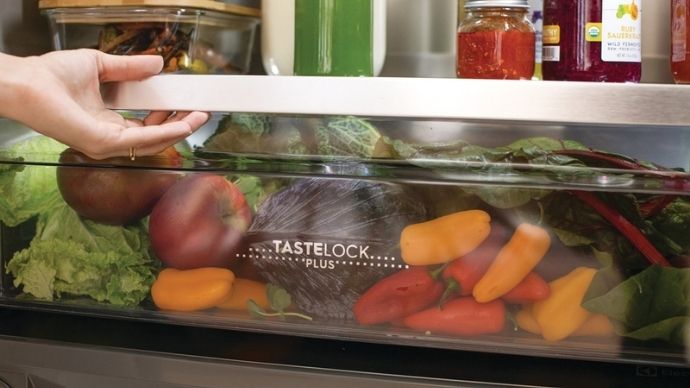From our friends at Electrolux!
Learn about the issues surrounding food waste and how you can minimize them.
Food waste is an issue found in almost every home, and it exists well beyond what we leave on our plates. It can even cause a variety of hardships at micro and macro levels, which is why Electrolux has created appliances designed to help reduce food waste. In this article, you’ll learn how food waste impacts your life and the world around you. Plus, we’ve included some simple steps you can take to minimize food waste in your own kitchen.
The many faces of food waste
What is food waste?
Food waste extends beyond the food we don’t eat at mealtime. Waste occurs throughout different stages in the food life cycle, starting with what happens on the farm. Every year, up to two-fifths of fruits and vegetables are rejected simply because they are misshapen, discolored or odd-sized.
We also waste a lot of food just making our meals. Leftover pieces and trimmings are generally just thrown away, rather than being incorporated into another meal.. Too often, we don’t eat everything we’ve been served, and what should be leftovers ends up in the trash can instead.
The transportation of food also results in food waste. Some of it becomes damaged in transport, while some is just lost along the way. Whether it’s on the shelf, in the fridge or stored in your panty, the greatest percentage of food waste happens when food is thrown away because no one was able to use it before its use-by date.
Food waste in America.
Americans have access to more food than many other nations in the world, and consequently, we waste a lot of it. In fact, 40 percent of the food produced in the United States ends up wasted, compared to 33 percent across the rest of the world. What’s more, we’re also misusing our farmland — 20 percent of all farmland is used to food that is never eaten.
Food waste impacts natural resources and the environment
Food waste also negatively affects the resources used to grow our food. The majority of produce in our stores requires a lot to go from seed to shelves, including water, fertilizer, pesticides, energy, packaging and land space. Every time food is wasted, a
portion of those resources are also wasted, which impacts our environment. We could lessen waste if we simply used more of our food.
Reducing food waste could also minimize the amount of greenhouse gases we release into our atmosphere. Food waste makes up a significant portion of the U.S.’ solid waste in landfills, and as it decomposes, it emits methane into the air. The released methane then absorbs the sun’s heat, which causes the atmosphere to warm. Reducing the amount of food waste we put in our trash cans to help slow the threat of climate change.
Ready to reduce?
Want to reduce your food waste? Here’s how:
There are a lot of smart, simple ways to reduce your food waste. To start, shop with intent. Take stock of what you already have before you go shopping to avoid duplicate purchases, and plan your meals to buy only the specific items you need.
Proper storage can also extend your food’s shelf life. Freezing anything that can be frozen until it’s time to use it, essentially presses pause on the use-by date. Canning fruits and vegetables is another excellent way to ensure your food can last a long time, and the only equipment you need is a stovetop. Purchasing appliances outfitted with technology that can keep food fresher for longer periods of time can add days or weeks to your produce’s lifespan.
Store your food with longevity in mind.
Date labels can be confusing, and a lot of perfectly good food is thrown away as a result. The problem with date labels, whether they’re “best-by,” “sell-by” or “use-by,” is that none of those dates actually indicate the food has gone bad. They just let either the consumer or the grocery store know that there is a time limit on ideal freshness; however, those crackers could still be delicious. The same goes for your milk, your canned goods and most of the items you keep in your fridge or pantry.
Before tossing any food, examine it. Most milk is good for five to seven days after its sell-by date. Canned goods are generally fine for two to five years — just check the cans for dents or bulges. You can usually tell if something has spoiled by a sight and smell test.
When it comes to produce, meats, and certain dairy, freezing is a great way to prolong their usability. If you don’t think you’ll be able to use them before they go bad, wrap them up and store them in the freezer. This method greatly extends your food’s lifespan.
Improve longevity with Electrolux technology.
The TasteLock™ Plus Crisper Drawers in select Electrolux refrigerators is designed to preserve the taste nature intended in fresh, farmers market produce. It keeps your leafy greens crisp, your berries juicy and your broccoli crunchy. It features adaptive humidity control to remove excess moisture and block out dry air. Plus, an ethylene absorber filters out the gas emitted by many fruits and vegetables that causes them to spoil.
Electrolux also has a variety of oven features to help you increase your food’s lifespan. Steam cooking keeps your food from losing its volume, ensuring you can get the most out of every meal while reducing food waste. Electrolux ovens also have Air Sous Vide, a process that makes it nearly impossible to burn your food, so you won’t have kitchen accidents that force you to throw away meals. And like steam cooking, Air Sous Vide prevents food from losing its volume.
Plus, all Electrolux ovens improve the reheating process, making leftovers a more appealing and delicious option than they previously were. Plus, when leftovers are eaten, food waste is minimized.

TasteLock™ Crisper
Preserve the taste nature intended in fresh, farmers market produce.

